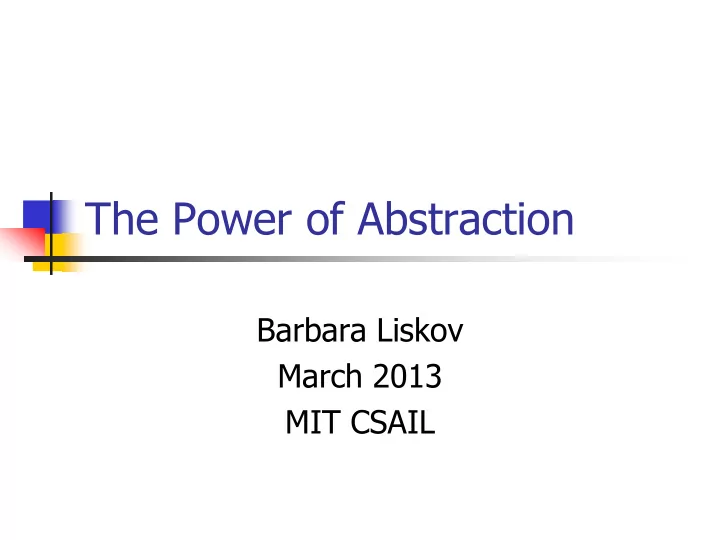

The Power of Abstraction Barbara Liskov March 2013 MIT CSAIL
Software is Complex Systems are big and they do complicated things and they may be distributed and/or concurrent
Addressing Complexity Algorithms, data structures, protocols
Addressing Complexity Algorithms, data structures, protocols Programming methodology Programming languages
This Talk Programming methodology as it developed Programming languages Programming languages today
The Situation in 1970 The software crisis!
Programming Methodology How should programs be designed? How should programs be structured?
The Landscape E. W. Dijkstra. Go To Statement Considered Harmful. Cacm, Mar. 1968
The Landscape N. Wirth. Program Development by Stepwise Refinement. Cacm, April 1971
The Landscape D. L. Parnas. Information Distribution Aspects of Design Methodology. IFIP Congress, 1971 “The connections between modules are the assumptions which the modules make about each other.”
Modularity A program is a collection of modules
Modularity A program is a collection of modules Each module has an interface, described by a specification
Modularity A program is a collection of modules Each has an interface, described by a specification A module’s implementation is correct if it meets the specification A using module depends only on the specification
Modularity A program is a collection of modules Each has an interface, described by a specification A module’s implementation is correct if it meets the specification A using module depends only on the specification E.g. a sort routine sort(a)
Benefits of Modularity Local reasoning Modifiability Independent development
The Situation in 1970 Procedures were the only type of module Not powerful enough, e.g., a file system Not used very much Complicated connections
Partitions B. Liskov. A Design Methodology for Reliable Software Systems. FJCC, Dec. 1972
Partitions op1 op2 op3 Partition state
From Partitions to ADTs How can these ideas be applied to building programs?
Idea Connect partitions to data types
Meeting in Savanah ACM Sigplan-Sigops interface meeting. April 1973. (Sigplan Notices, Sept. 1973) Started to work with Steve Zilles
The Landscape Extensible Languages S. Schuman and P. Jourrand. Definition Mechanisms in Extensible Programming Languages. AFIPS. 1970 R. Balzer. Dataless Programming. AFIPS. 1967
The Landscape O-J. Dahl and C.A.R. Hoare. Hierarchical Program Structures. Structured Programming, Academic Press, 1972
The Landscape J. H. Morris. Protection in Programming Languages. Cacm. Jan. 1973
Abstract Data Types B. Liskov and S. Zilles. Programming with Abstract Data Types. ACM Sigplan Conference on Very High Level Languages. April 1974
What that paper proposed Abstract data types A set of operations And a set of objects The operations provide the only way to use the objects A sketch of a programming language
From ADTs to CLU Participants Russ Atkinson Craig Schaffert Alan Snyder
Why a Programming Language? Communicating to programmers Do ADTs work in practice? Getting a precise definition Achieving reasonable performance
Some Facts about CLU Static type checking Heap-based Separate compilation No concurrency, no gotos, no inheritance
CLU Mechanisms Clusters Polymorphism Iterators Exception handling
Clusters IntSet = cluster is create, insert, delete, … % representation for IntSet objects % implementation of the operations end IntSet
Clusters IntSet = cluster is create, insert, delete, … % representation for IntSet objects % implementation of the operations end IntSet IntSet s = IntSet$create( ) IntSet$insert(s, 3)
Polymorphism Set = cluster[T: type] is create, insert, … % representation for Set object % implementation of Set operations end Set Set[int] s := Set[int]$create( ) Set[int]$insert(s, 3)
Polymorphism Set = cluster[T: type] is create, insert, … where T has equal: proctype(T, T) returns (bool)
Iterators For all x in C do S
Iterators For all x in C do S Destroy the collection? Complicate the abstraction?
Visit to CMU Bill Wulf and Mary Shaw, Alphard Generators
Iterators sum: int := 0 for e: int in Set[int]$members(s) do sum := sum + e end
Also Exception handling Strong specifications, e.g., IntSet$choose First class Procedures and Iterators
After CLU Argus and distributed computing Programming methodology Modular program design Reasoning about correctness Type hierarchy
From CLU to Object-Oriented Programming SmallTalk provided inheritance
The Landscape Inheritance was used for: Implementation Type hierarchy
Type Hierarchy Wasn’t well understood E.g., stacks vs. queues
The Liskov Substitution Principle (LSP) Objects of subtypes should behave like those of supertypes if used via supertype methods B. Liskov. Data abstraction and hierarchy. Sigplan notices, May 1988
What Next? Modularity based on abstraction is the way things are done
Programming Languages Today Languages for experts, e.g., Java, C#
Programming 1A E.g., Python
Challenges A programming language for novices and experts Ease of use vs. expressive power Readability vs. writeability Modularity and encapsulation Powerful abstraction mechanisms State matters
Challenges Massively-parallel computers Programming methodology Programming language support
The Power of Abstraction Barbara Liskov March 2013 MIT CSAIL
Recommend
More recommend